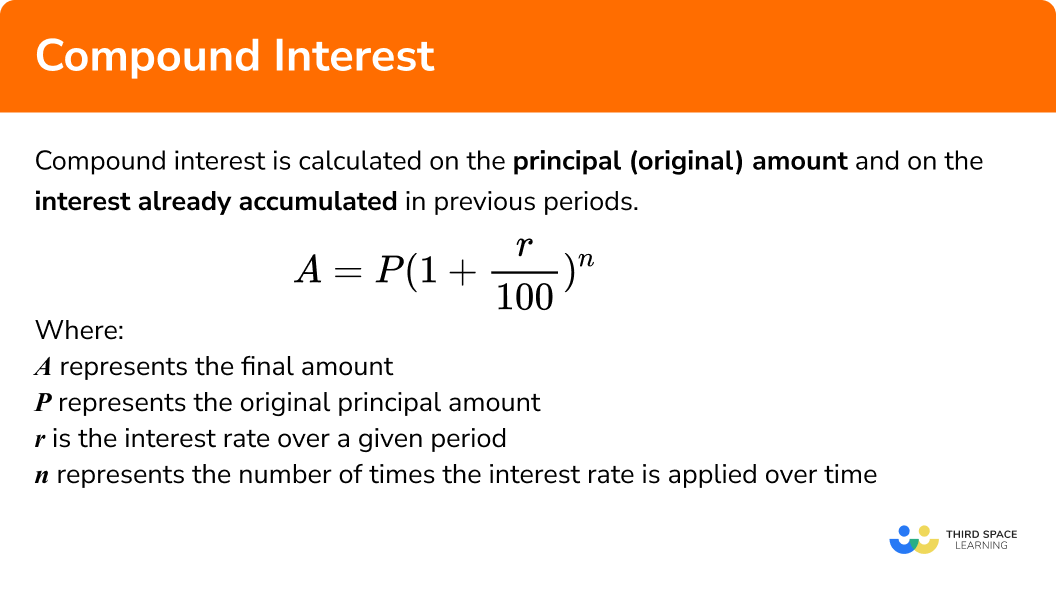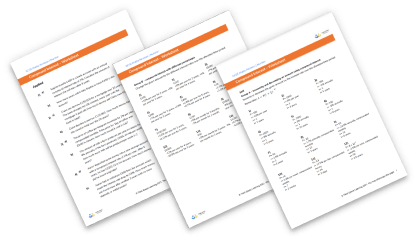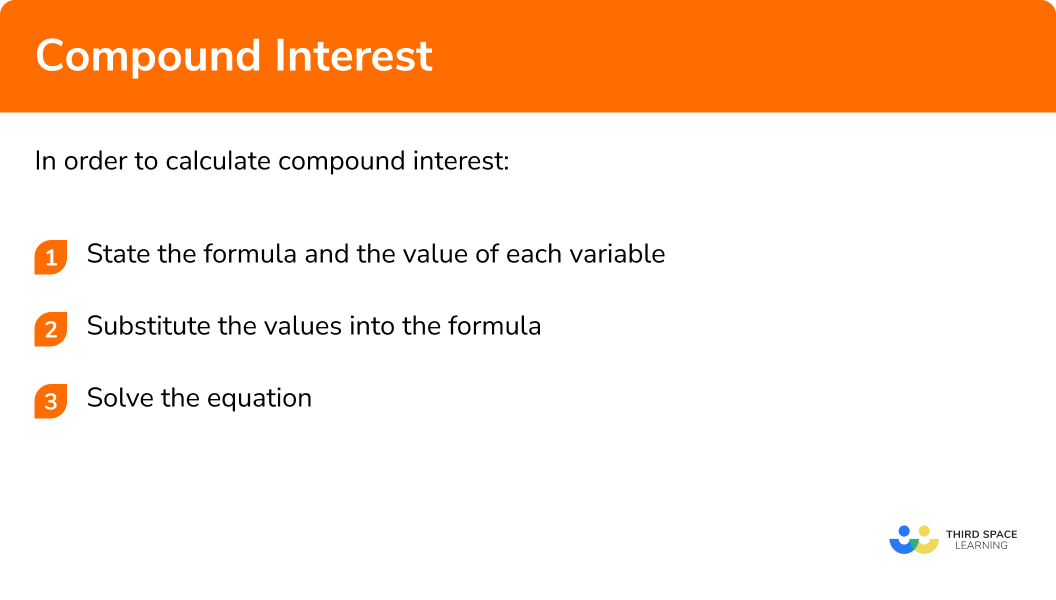One to one maths interventions built for KS4 success
Weekly online one to one GCSE maths revision lessons now available
In order to access this I need to be confident with:
Percentage to decimal Substitution Percentage change Calculator skillsThis topic is relevant for:

Compound Interest
Here is everything you need to know about compound interest for GCSE maths (Edexcel, AQA and OCR). You’ll learn how to calculate compound interest for increasing and decreasing values, and set-up, solve and interpret growth and decay problems.
Look out for the compound interest worksheet and exam questions at the end.
What is compound interest?
Compound interest means that every time interest is paid on an amount the added interest will also receive interest thereafter.
Compound interest is calculated on the principal (original) amount and the interest already accumulated on previous periods.
For example, take the amount of money in a savings account.
If you put £100 in an account with an annual interest rate of 10%, the value of the money in the account will increase by 10% in year one.
The new amount of money in the account will be £110 or 110% of the original.
In year two the value of the money in the account will increase by 10% again.
The new amount would be £121 or 121% of the original. This because we have increased £110 by 10%.
What is compound interest?

Compound interest formula
Compound interest is interest calculated on top of the original amount including any interest accumulated so far. The compound interest formula is:
Where:
A represents the final amountP represents the original principal amountr is the interest rate over a given periodn represents the number of times the interest rate is applied
E.g.
Let’s calculate a 3% increase (per year) on an amount
If we were to calculate the amount after each year, we could just use the a multiplier of 1.03 to find each amount.
This P\times 1.03 gives the value after the first year.
The second year’s amount is this amount, multiplied by a further 1.03 and so on for the amount of years. This can be expressed using a table.
| Year | Interest Calculation | Simplified Interest Calculation |
| Year 0 | P | P × 1.030 |
| Year 1 | P × 1.03 | P × 1.031 |
| Year 2 | P × 1.03 × 1.03 | P × 1.032 |
| Year 3 | P × 1.03 × 1.03 × 1.03 | P × 1.033 |
| Year t | P × 1.03 × 1.03 × 1.03 × … | P × 1.03n |
After
So for this example, multiplying
Compound Depreciation is when the value of something decreases by a percentage rate compoundly. Here we can use the same formula but the interest rate will be negative.

Compound interest formula worksheet

Get your free compound interest formula worksheet of 20+ questions and answers. Includes reasoning and applied questions.
DOWNLOAD FREE
Compound interest formula worksheet

Get your free compound interest formula worksheet of 20+ questions and answers. Includes reasoning and applied questions.
DOWNLOAD FREERelated lessons on simple and compound interest
Compound interest is part of our series of lessons to support revision on simple interest and compound interest. You may find it helpful to start with the main simple interest and compound interest lesson for a summary of what to expect, or use the step by step guides below for further detail on individual topics. Other lessons in this series include:
How to calculate compound interest
In order to calculate compound interest:
- State the formula and the value of each variable.
- Substitute the values into the formula.
- Solve the equation.
Explain how to calculate compound interest in 3 steps

Compound interest formula examples
Example 1: compound interest (percentage increase)
£8500 is invested for 5 years at 0.3% per year compound interest. What is the value of the investment after this time?
- State the formula and the value of each variable.
Here we use the formula
with:
P = 8500r = 0.3n = 5
2Substitute the values into the formula.
Substituting these values into the compound interest formula
we get:
3Solve the equation.
Example 2: compound depreciation (percentage decrease)
A vacuum cleaner is bought for £399 and loses 22% of its value per year compound depreciation. What is the value of the vacuum cleaner after 2 years?
State the formula and the value of each variable.
Here we use the formula
with:
P = 399r = − 22n = 2
Substitute the values into the formula.
Substituting these values into the compound interest formula
we get:
Solve the equation.
Example 3: compound interest (compounding periods)
A house is valued at £150 000. On average, the house price increases by 0.24% monthly compounding over 2.5 years. What is the future value of the house after this time?
State the formula and the value of each variable.
This time the interest rate in monthly so we need to convert the time into months.
2.5 year is the same as 2.5\times 12 = 30 months.
Here we use the formula
with:
P = 150000r = 0.24n = 30
Substitute the values into the formula.
Substituting these values into the compound interest formula
we get:
Solve the equation.
Example 4: compound increase (writing an answer in standard form)
Bacteria reproduce at a rate of 3% per hour. If there are 1.2 x 107 bacteria in a petri dish at hour 0, how many bacteria are in the petri dish after 4 hours?
State the formula and the value of each variable.
Here we use the formula
with:
P = 1.2 × 107r = 3- n = 4
Substitute the values into the formula.
Substituting these values into the compound interest formula
we get:
Solve the equation.
Example 5: compound interest (best buy)
Two offers exist for the same car.
| Offer A | Offer B |
| 6% APR for 3 years | 3% APR for 5 years |
A car has a value of £7999. Which offers a better value over the period of time stated?
State the formula and the value of each variable.
Here we are calculating compound interest with the formula
twice as we are comparing each offer:
| Offer A | Offer B |
n = 3 | n = 5 |
Substitute the values into the formula.
Substituting these values into the simple interest formula
we get:
Offer A
\\A=7999(1+0.06)^{3}\\
Offer B
\\A=7999(1+0.03)^{5}\\
Solve the equation.
Offer A
\\A=7999\times{1.06}^{3}\\
\\A=\pounds{9526.94}\\
Offer B
\\A=7999\times{1.03}^{5}\\
\\A=\pounds{9273.03}\\
The best offer is Offer B (remember to state your conclusion).
Common misconceptions
- Applying the incorrect formula to the question
This is a very common mistake where simple interest is calculated instead of using compound interest.
- Incorrect percentage change due to different time scales
Here is example 3 with this misconception:
A house is valued at £150,000. On average, the house price increases by 0.24% per month over a period of 2.5 years compound interest. What is the value of the house after this time?
Here we use the formula
with:
P = 150000r = 0.24n = 2.5
Although the answer here looks reasonable, the 0.24% interest is per month not per year, which is what has been calculated.
- Using the incorrect value for the percentage change
Not dividing the percentage rate by 100 is a common error. For example when using compound interest to increase £100 by 2% for 5 years, this calculation is made:
This is clearly wrong. We need to instead divide 2 by 100 to give 0.02. This gives a sensible final answer of £101.41.
- Using a positive value for r when it should be negative
If a value is depreciating (going down), the value of
Practice compound interest formula questions
1. The amount of water in a pond changes throughout the year. For 6 months of the year, the water level increases by an average of 1\% . For the other 6 months of the year, the water level drops by 0.7\% . If the pond contains 400L at the beginning of the year, how much water is in the pond at the end of the first year?




The pond starts with 400L of water. We are dealing with two 6 month time periods with a different multiplier for each one.
The amount of water is given by 400\times(1+0.01)^{6}\times(1-0.007)^{6} .
2. A bar of soap decreases in weight every time it is used by 3\% compound interest. If the bar of soap weighs 50g at the start of the week, and it is used 45 times, how much does it now weigh?




Using the compound interest formula results in the following calculation: 50\times(1-0.03)^{45}=12.7 \quad (3sf) .
3. The Amazon rainforest covers an area of 5.5 million km^2 in 2021 . If the rate of deforestation is 0.2\% , what is the expected area of the rainforest in 2030 ?




Using the compound interest formula results in the following calculation, with the answer rounded to the nearest integer: 5500000\times(1-0.002)^{9}=5401788 .
4. Account A has an annual percentage yield of 2.5\% compound interest. Account B has an interest rate of 0.2\% per month compound interest. If the initial investment is £3000 , how much more money has Account B accumulated than Account A in interest after 40 months?




After 40 months Account A has accumulated £230.67 in interest as 3 years interest has been accrued.
After 40 months Account B has accumulated £249.60 in interest as 40 months interest has been accrued.
The difference is £18.93 .
5. A bucket is leaking water at a rate of 17\% per hour, compound depreciation. How many hours would it take for the bucket to be under half full?
2 hours

3 hours

4 hours

5 hours

After 1 hour the bucket is 83\% full.
After 2 hours the bucket is 68.89\% full.
After 3 hours the bucket is 57.18\% full.
After 4 hours the bucket is 47.46\% full.
6. A battery loses its charge at a rate of 5\% every 2 hours, compound depreciation. If a battery starts fully charged, what percentage charge is left after 8 hours? Write your answer to 2 decimal places.




We could use the compound interest formula, or look at how the battery changes over time.
After 2 hours the battery is 95\% full.
After 4 hours the battery is 90.25\% full.
After 6 hours the battery is 85.74\% full.
After 8 hours the battery is 81.45\% full.
Compound interest formula GCSE questions
1. (a) An initial deposit of £1400 is invested for 3 years. The interest payments occur annually at 6\% compound interest. Work out the amount of interest earned after this time.
(b) After the first 3 years, the interest rate falls to 2\% . How much would the investment be worth after a further 4 years?
(4 marks)
(a)
1400 × (1.06)^{3}
(1)
£1667.42-1400 = £267.42
(1)
(b)
1667.42 × (1.02)^{4}
(1)
£1804.87
(1)
2. (a) A car is bought for £15 000 . The car loses 10\% of its value every year, compound interest. Which calculation works out the total value after 5 years? Circle your answer.
- 15000 − 10 × 5
- (15000 10) × 5
- 1.1^{5} × 15000
- 15000 × 0.9^{5}
(b) The car is paid for using a credit card. Every month, £1500 of the bill is paid off, but 0.2\% of the remaining bill is added after. Calculate the balance on the credit card after 3 months.
(4 marks)
(a)
15000 × 0.9^{5}
(1)
(b)
13500 × 1.002 = £13527 (month 1)
(1)
12027 × 1.002 = £12051.05 (month 2)
(1)
10551.05 × 1.002 = £10572.16 (month 3)
(1)
3. (a) Kieran invests in multiple financial institutions using the stock market. After the first 3 years, he has made an average of 3\% interest per year, compound interest. For the next two years, his stock prices fall by a compound interest rate of 4\% each year. If the original investment was worth £13,000 , calculate the future value of the investment after 5 years.
(b) Harry invested in the same stock, with his investment after 5 years having the present value of £7500 . What was his original investment worth?
(8 marks)
(a)
13000 × (1.03)^{3}
(1)
£14205.45
(1)
14205.45 × (0.96)^{2}
(1)
£13091.74
(1)
(b)
7500 / (0.96)^{2}
(1)
£8138.02
(1)
8138.02 / (1.03)^{3}
(1)
£7447.44
(1)
Learning checklist
You have now learned how to:
- Solve problems involving percentage change, including: percentage increase, decrease and original value problems and simple interest in financial mathematics
- Set up, solve and interpret the answers in growth and decay problems, including compound interest (and work with general iterative processes)
The next lessons are
Still stuck?
Prepare your KS4 students for maths GCSEs success with Third Space Learning. Weekly online one to one GCSE maths revision lessons delivered by expert maths tutors.

Find out more about our GCSE maths tuition programme.